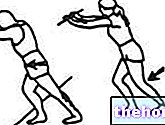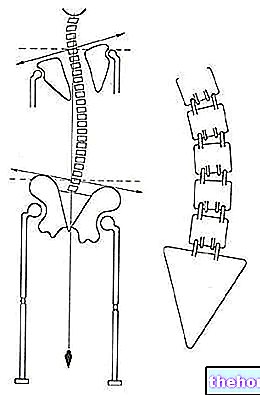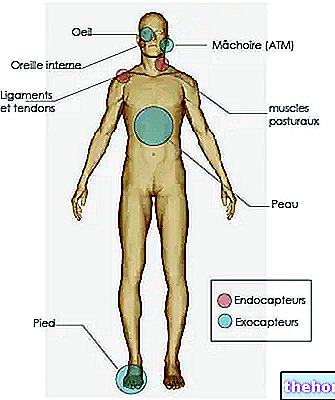Definition
The term rhabdomyolysis indicates severe damage to skeletal muscle, resulting in the release into the bloodstream of numerous compounds, such as myoglobin, but also creatine, calcium, potassium and uric acid.

Causes of rhabdomyolysis
The possible triggers can be classified into physical and non-physical. Among the physical causes we find muscle damage related to "intense sporting activity such as bodybuilding (exertional rhabdomyolysis, partly responsible for DOMS), trauma - reported for example with a car accident or an electric shock - and finally cardiovascular disease - the latter can clog blood vessels preventing adequate blood supply to the muscles.
Among the non-physical causes of rhabdomyolysis we find various muscular disorders (myopathies) and poisoning by heavy metals, by poisons injected by insect bites or by snake bites, by toxins present in food - as in a particular species of fungus, the Equestrian tricholoma - in some vegetable plants, such as Conium maculatum (also known as Hemlock), and in some species of fish. Among the other possible non-physical causes of rhabdomyolysis we find alcohol abuse, infections affecting bacteria (salmonella, legionella) and viruses (herpes and malaria), and the use of drugs, such as heroin, methamphetamines, cocaine , ketamine and MDMA, known as ecstasy; finally, a trigger can be represented by the use of some medical devices, such as drugs, anesthesia and electrolytes. For this reason, if the person is being treated with drugs whose effect is to lower the total cholesterol level in the blood - particularly if they contain statins and / or fibrates - you must pay close attention to the appearance of tiredness, muscle aches and change in the color of your urine, all symptoms that can be clear signs of rhabdomyolysis.
Symptoms
Rhabdomyolysis is characterized by very specific symptoms; among these we mention a general fatigue and a reddish-brown coloration of the urine, due to the pouring of the myoglobin pigment into the blood. To be more precise, in diagnosing rhabdomyolysis it is necessary to proceed with a blood and urine analysis. These two analyzes mainly focus on the determination of four parameters. The first is represented by the creatine kinase enzyme; based on the concentration of this enzyme in the blood it is possible to determine the extent of muscle damage (normal values 0-150 U / liter, slightly variable from laboratory to laboratory and lower in women). Of course, the higher the concentration of creatine kinase, the more the muscle damage will be severe.
The second parameter that is identified, through urinalysis, is the presence of myoglobin (myoglobinuria). As previously mentioned, myoglobin is nephrotoxic because, if present in the blood, it tends to accumulate in the kidneys, causing serious problems in these organs. When the level of myoglobin exceeds the gram / liter, the urine takes on a very dark color.
The third parameter observed is the presence of altered levels of potassium, calcium, uric acid and azotemia. It should be remembered that the calcium level can vary with the course of the disease; in particular, in the initial stage of rhabdomyolysis the value tends to be low (hypocalcemia). Subsequently, with the advancement of muscle necrosis, a hypercalcemia can be appreciated, given the high release of calcium from the damaged muscle cells.
Finally, the fourth observable parameter is the level of creatinine (normal value 50-100 micromoles / liter), which is always released by damaged muscle cells.
Treatment and prevention of rhabdomyolysis
See also: drugs to treat rhabdomyolysis
There are many possible medical treatments for rhabdomyolysis. Among these, the most successful is hydration with fluids through intravenous administration. This procedure, in fact, prevents possible damage due to myoglobin released into the blood. Another very valid therapeutic solution, useful only for the most serious cases, is hemodialysis, the purpose of which is to filter the blood and retain potentially harmful substances. To treat the complications of rhabdomyolysis, it may also be necessary to take diuretic drugs (such as furosemide), useful for increasing the production of urine and avoid possible kidney complications.
To prevent rhabdomyolysis, it is necessary to drink plenty of fluids before, during and after strenuous exercise to dilute the urine and facilitate the elimination of myoglobin from the kidneys. A very important advice to prevent this disease is to warn your doctor at the first appearance of the classic symptoms of rhabdomyolysis, especially if you are predisposed to developing it (presence of myopathies or taking statins).
Healing times
Depending on the severity of rhabdomyolysis, healing times may vary. If the disease is diagnosed quickly, then at the onset of the first symptoms, the recovery time is just as short, and is between a week and a month. In severe cases, therefore in the presence of kidney damage, recovery times from rhabdomyolysis are significantly longer and characterized by the persistence of symptoms such as muscle fatigue and general weakness.
Select Blood Tests Blood Tests Uric acid - uricaemia ACTH: adrenocortitotropic hormone Alanine amino transferase, ALT, SGPT Albumin Alcoholism Alphafetoprotein Alphafetoprotein in pregnancy Aldolase Amylase Ammonemia, ammonia in the blood Androstenedione Antibody-endomysial antibodies Anti-gliadicides Nucleus Helicobacter pylori antibodies Embryo carcinoal antigen - CEA Prostate specific antigen PSA Antithrombin III Haptoglobin AST - GOT or aspartate aminotransferase Azotemia Bilirubin (physiology) Direct, indirect and total bilirubin CA 125: tumor antigen 125 CA 15-3: tumor antigen 19-9 as tumor marker Calcemia Ceruloplasmin Cystatin C CK-MB - Creatine kinase MB Cholesterolemia Cholinesterase (pseudcholinesterase) Plasma concentration Creatine kinase Creatinine Creatinine Creatinine clearance Chromogranin A D-dimer Hematocrit Blood culture Hemocrome Hemoglobin Glycated hemoglobin a Blood tests Blood tests, Down syndrome screening Ferritin Rheumatoid factor Fibrin and its degradation products Fibrinogen Leukocyte formula Alkaline phosphatase (ALP) Fructosamine and glycated hemoglobin GGT - Gamma-gt Gastrinemia GCT Glycemia Red blood cells Granulocytes HE4 and Cancer at "Ova" Immunoglobulins INR Insulinemia Lactate dehydrogenase LDH Leukocytes - white blood cells Lymphocytes Lipases Tissue damage markers MCH MCHC MCV Metanephrines MPO - Myeloperoxidase Myoglobin Monocytes MPV - average platelet volume Natremia Neutrophils Homocysteine Thyroid hormones OGTT Osmocyte Plasma protein A associated with pregnancy Peptide C Pepsin and pepsinogen PCT - platelet or platelet hematocrit PDW - distribution width of platelet volumes Platelets Plateletpenia PLT - number of platelets in blood Preparation for blood tests Prist Test Total IgEk Protein C (PC) - Protein C Activated (PCA) C Reactive Protein Rast Protein Test Specific IgE Reticulocytes Renin Reuma-Test Oxygen Saturation Sideremia BAC, BAC TBG - Thyroxine Binding Globulin Prothrombin Time Partial Thromblopastin Time (PTT) Activated Partial Thromboplastin Time (aPTT) Testosterone Testosterone: free and bioavailable fraction Thyroglobulin Thyroxine in the blood - Total T4, free T4 Transaminases High transaminases Transglutaminase Transferrin - TIBC - TIBC - UIBC - saturation of transferrin Transtyretin Triglyceridemia Triiodothyronine in the blood - Total T3, free T3 Troponin TRH and Troponins of s thymol to TRH TSH - Thyrotropin Uremia Liver values ESR VDRL and TPHA: serological tests for syphlis Volemia Conversion of bilirubin from mg / dL to µmol / L Conversion of cholesterol and triglyceridemia from mg / dL to mmol / L Conversion of creatinine from mg / dL to µmol / L Conversion of blood glucose from mg / dL to mmol / L Conversion of testosteronemia from ng / dL - nmol / L Conversion of uricemia from mg / dL to mmol / L




























